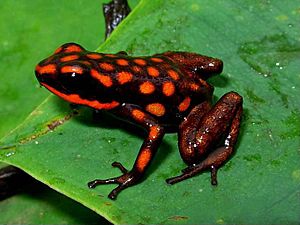Dotted poison frog facts for kids
Quick facts for kids Dotted poison frog |
|
|---|---|
 |
|
| Conservation status | |
| Scientific classification | |
| Genus: |
Andinobates
|
| Species: |
dorisswansonae
|
The dotted poison frog, known scientifically as Andinobates dorisswansonae, is a small amphibian. It belongs to the Dendrobatidae family, which includes many types of poison dart frogs. This special frog lives only in Colombia, specifically near the town of Falan and in the northern part of the Tolima Department. It is known to be poisonous if touched or eaten by humans.
Contents
What Does the Dotted Poison Frog Look Like?
This frog has very bright skin. It can be shiny black or dark brown. On its body, you'll see colorful spots that are red, orange, or yellow.
One special thing about this frog is its feet. Its first and second toes are joined together. This unique feature helps scientists tell it apart from other similar frogs. Only one other frog, Andinobates daleswansoni, shares this trait.
How big are these frogs? Male dotted poison frogs are usually between 16.2 and 17.1 millimeters long. Females are a bit larger, measuring from 17.5 to 19.4 millimeters. That's about the size of a small button!
How Does the Dotted Poison Frog Live?
The dotted poison frog likes to live on the forest floor. It hides among fallen leaves in secondary forests. These are forests that have grown back after being cut down. They need a good tree canopy, which means lots of branches and leaves overhead.
These frogs also like places with bromeliads. Bromeliads are plants that can hold water in their leaves. The female frog lays her tadpoles in these small pools of water. The parents take good care of their young. They carry the tadpoles on their backs to a water source.
What do they eat? Dotted poison frogs mostly eat small insects. Their favorite food is ants.
Who Discovered This Frog?
The dotted poison frog was first found by Oscar Javier Gallego Carvajal. He was a researcher from the University of Tolima. He discovered the frog in a small part of a secondary forest in a village called El Llano, near Falan.
The scientific description of this new species was published in 2006. Oscar Javier Gallego Carvajal worked with other scientists on this project. They included José Vicente Rueda Almonacid, Marco Rada, Santiago J. Sánchez Pacheco, and Alvaro Andrés Velásquez Alvarez. They were all part of Conservación Internacional Colombia. Their findings were shared in a science journal called Zootaxa.
What Threats Does This Frog Face?
Sadly, the dotted poison frog is facing several dangers. Its home, the forest, is shrinking. This is because of logging, where trees are cut down. It's also threatened by farming, as more land is cleared for crops.
Sometimes, these frogs are also hunted. People might try to catch them to keep as pets or to display them. These activities put the dotted poison frog at risk.
See also
 In Spanish: Ranita venenosa punteada para niños
In Spanish: Ranita venenosa punteada para niños


